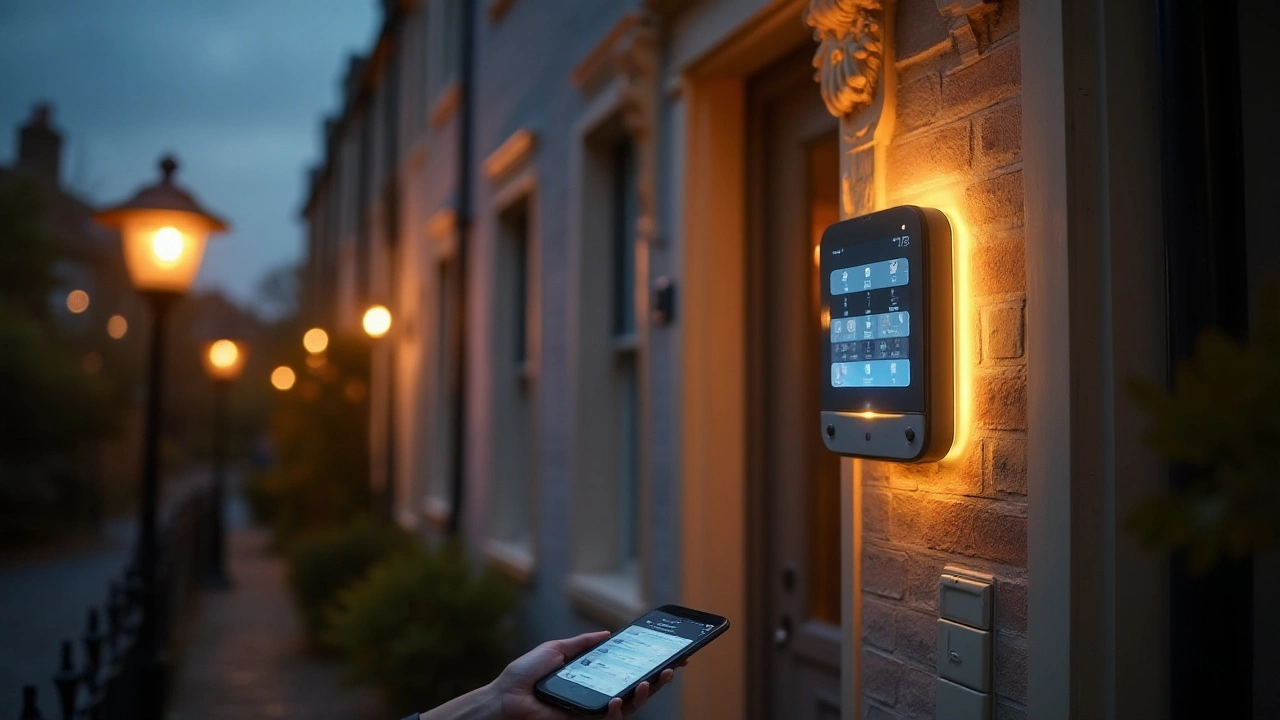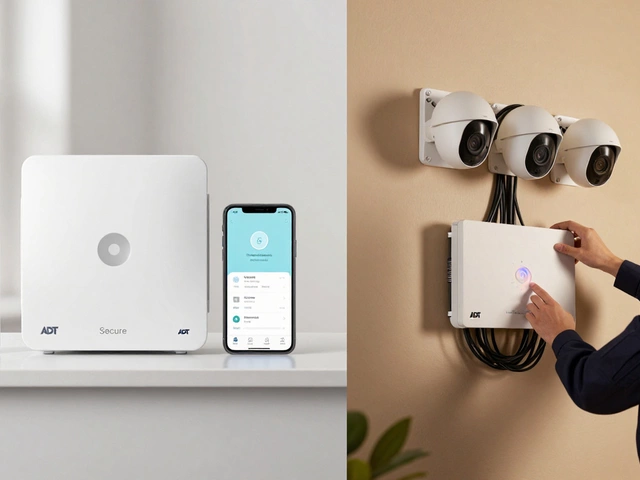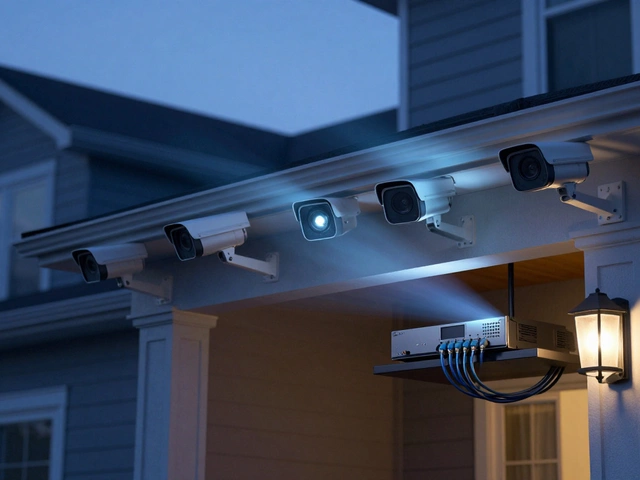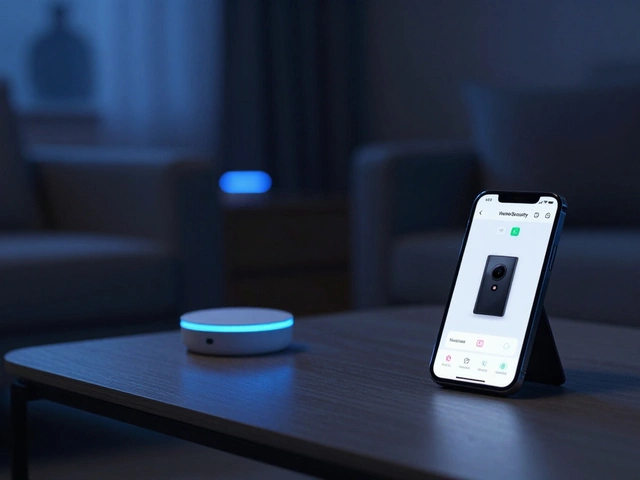When it comes to safeguarding your home, ADT is a name almost every household recognizes. But what if there are options that not only match but exceed what ADT offers? In the evolving landscape of home security, a range of alternatives are making their mark, bringing innovative technologies and user-centric solutions that could outshine traditional providers like ADT.
Diving into a world rich with options might feel overwhelming at first. What you need to know is that various systems are now combining excellent protection with cutting-edge smart home integrations. They also ensure that managing your home's safety isn't wrapped up in complicated processes. These alternatives offer sleek designs, intuitive apps, and competitive pricing, making them worthwhile contenders in the home security market.
This is the guide where you'll discover which systems are leading the pack, what features set them apart from ADT, and how you can get the most bang for your buck. Whether you’re looking to ramp up security or streamline it with your smart home devices, there are choices out there tailor-made just for you.
- Why Look Beyond ADT?
- Smart Innovations in Home Security
- Comparing Popular Alternatives
- Cost and Value Considerations
- Integrations and User-Friendly Features
- Tips for Choosing the Best Security System for Your Home
Why Look Beyond ADT?
Many homeowners find themselves investigating alternatives to ADT, driven by an evolving market and changing needs. While ADT has certainly established itself as a stalwart name in the home security arena, its offerings can sometimes feel dated compared to what's emerging today. One key motivator for considering other options is the cost factor. ADT often demands a premium price due to its brand name and the extensive services it claims to provide, which can feel unnecessary if your needs lean more towards flexibility and affordability. In recent years, several new players have emerged with competitive pricing structures, sometimes eliminating the need for long-term contracts which ADT requires.
According to a study by Smart Home Magazine, "65% of homeowners sought systems with higher customization capabilities rather than sticking with traditional setups."Embracing customization is another aspect where ADT alternatives shine. Many systems now allow for a tailored approach, offering add-ons or special features that can be handpicked to meet unique household requirements. This modular nature isn't something ADT typically offers as it's more of an all-or-nothing package. This flexibility not only enhances user satisfaction but also ensures that you are only paying for features that will actually be used. In our fast-paced world, these agile, adaptive systems are ticking all the boxes for what modern homeowners really want.
Technology integration is yet another compelling reason to look beyond ADT. With the rise of smart home technologies, a security system that doesn't seamlessly integrate with your existing devices may restrict future smart home expansions. ADT still has restrictive points when it comes to compatibility with various smart home ecosystems. In contrast, brands like Simplisafe or Ring tend to offer smoother integrations, granting you control over your security setup from a singular platform. Homeowners with systems like Alexa or Google Home gain significantly from these smoother integrations, ensuring their security fits snugly within a larger ecosystem of interconnected devices.
Last but not least, ease of use is paramount to modern security solutions. Many younger homeowners nowadays look for systems that provide an easy-to-navigate interface, simple app controls, and the capability to monitor their home environment from anywhere. Younger generations who grew up in the tech boom value seamless user experiences, which leads them to choose alternatives over ADT, which might not be as tailored in its digital user interfaces. Personal preferences vary, but the market clearly showcases a shift towards more intuitive user experiences that offer not just security, but a peace of mind that’s accessible at the user's fingertips.
Smart Innovations in Home Security
As technology continues to march forward, the home security landscape has transformed radically, and for the better. Today, the smart home security systems are changing how we protect our homes and our loved ones. One significant innovation is the integration of artificial intelligence in home security, making devices smarter and more responsive than ever. Camera systems now boast motion sensors that not only detect movement but can differentiate between a passing car and someone sneaking around your backyard, reducing false alarms significantly. This advancement alone sets many modern systems apart from traditional services such as ADT.
Another noteworthy trend is the seamless coupling of security systems with IoT devices. Imagine your security system communicating with your smart doorbell, thermostat, and lights. This connectivity doesn’t just make your home safer; it makes it more energy efficient. With the ability to control multiple aspects of your home with a single app interface, smart home security systems are designed for operational ease and heightened convenience. A study by the Journal of Smart Home Technology found that integrated systems reduced energy consumption by up to 20%, an unexpected perk to upgrading your security.
Integrating Voice Commands
Among the newer features in this sector are voice command capabilities. People are increasingly relying on their virtual assistants not only to play music but to arm their security systems or check the status of their doors. This is where voice-enabled technology shines, providing a hands-free approach to managing household safety. Brands like Amazon Alexa and Google Assistant are now part of the security landscape, offering users a personalized experience that ADT’s traditional systems might not cater to.Dependability and Real-Time Alerts
In terms of speed and dependability, the evolution of real-time alerts cannot be overstated. Modern security systems send instant notifications to your smartphone as soon as an anomaly is detected, whether you're at your desk or on a tropical beach. This real-time information can make a critical difference in preventing potential threats, giving you the peace of mind traditional *landline systems simply cannot promise.* In 2022 alone, advancements in real-time alert accuracy reportedly prevented countless break-ins by notifying homeowners and authorities before the situation could escalate."As home security solutions continue to innovate, they're not just keeping families safe; they're enhancing the quality of life through cutting-edge technology," notes Rita Peterson, a prominent analyst at Smart Homes Today.
So, when considering alternatives to ADT, these technological breakthroughs should not be overlooked. Smart systems are designed to integrate into our digital lives seamlessly, offering a level of customizable control and sophisticated security that is truly modern. As innovations continue to evolve, one thing is clear: the future of home security lies in its ability to adapt and integrate with the devices that are already part of our everyday lives.

Comparing Popular Alternatives
When we set out to explore options that might compete with ADT in the home security realm, several names stand out, each bringing its own unique set of features and benefits. Companies like Ring, SimpliSafe, and Nest are not only carving their niche but are also pushing the boundaries of what security can mean in a modern home. Their approach often revolves around smarter technology, better customer service, and more affordable solutions, which can be particularly appealing to tech-savvy homeowners and budget-conscious families alike.
Consider Ring, which has quickly become a household name in the arena of security cameras and doorbells. With its range of devices, Ring prioritizes accessibility and ease of use, allowing users to monitor their premises with just a few taps on their smartphone. The integration with Alexa adds to the appeal, offering verbal command functionalities that only add to the user experience. Ring's pricing plans are straightforward, allowing users to scale their protection based on specific needs, making it a flexible option compared to ADT's often rigid plans. According to Consumer Reports, "Ring's ease of use and effective monitoring make it a strong contender for those new to home security."
SimpliSafe vs. ADT
SimpliSafe takes a different approach by offering no long-term contracts, a feature that sets it apart and certainly appeals to many users wary of commitments. The installation process is often highlighted for its simplicity, making it possible for users to set up their systems in less than an hour without professional help. SimpliSafe's equipment is designed with a focus on functionality and affordability, and their monitoring services are considered reliable. They've tailored their offerings to be both budget-friendly and effective, which often presents a more attractive starting point for users new to home security.
Nest, part of the Google family, has also made significant strides in the market. The integration with other Google services enhances the experience for those living in a smart home environment. Nest's cameras boast cutting-edge technology, such as facial recognition, which allows users to receive specific alerts for known individuals. Though slightly more expensive, the investment pays off for those who prioritize high-quality video feeds and smart home integrations. For someone embedded in Google's ecosystem, Nest naturally aligns with existing devices and services, providing a seamless and efficient user journey.
| Feature | ADT | Ring | SimpliSafe | Nest |
|---|---|---|---|---|
| Contracts | Yes | No | No | Optional |
| Smart Integrations | Limited | Strong | Moderate | Strong |
| Installation | Professional | Self/Professional | Self | Self |
These ADT alternatives highlight the shift towards more intelligent, user-centric security solutions. By comparing these options, it's clear that the traditional model has been challenged by a wave of new thinking. Homeowners today are not just looking for security; they're seeking flexibility, affordability, and seamless integration with their ever-growing array of smart devices. These alternatives are setting new standards, putting control back into the hands of the users, and showing that the future of home security is not about settling for what has been but choosing what can be.
Cost and Value Considerations
When evaluating home security options, balancing cost and value is paramount. Homeowners are often faced with the challenge of finding a system that offers both affordable pricing and reliable security. Unlike ADT, which can be burdened with premium fees for their brand recognition and long-term contracts, several newer contenders are offering flexibility and transparency in pricing. Imagine this scenario: instead of being tied down to a lengthy contract, you have the agile freedom to adjust your security needs as your life changes. This is a freedom that many modern systems embrace, understanding that today's consumers are more informed and selective than ever.
To make sense of the myriad options, it's essential to consider the different pricing models available. Some companies operate on a monthly subscription basis with a flat fee that covers professional monitoring and equipment installation. Others allow the flexibility of a pay-as-you-go model, which is ideal if you're unsure about long-term commitments. Moreover, with advancements in security cameras and wireless technology, the initial equipment costs have decreased significantly, making advanced security systems more accessible to families and individuals alike.
A clear point of comparison lies in the equipment packages offered. For example, companies like SimpliSafe and Ring, known in the ADT alternatives space, frequently bundle equipment at discounted rates if you choose their monitoring services. This bundling not only saves money but ensures that all gadgets are optimized to work together seamlessly. For those who value keeping up with the latest technology, many providers offer upgrade paths, replacing or enhancing parts of your system without any hassle. Such options can be enticing for tech-savvy users who appreciate having the latest system with minimal fuss.
It is crucial to consider not just what you pay initially but the ongoing costs as well. For instance, monitoring fees can range widely, impacting long-term affordability. Many providers now include app control, customization settings, and smart integrations as a standard, which were once premium features. This shift has had a democratizing effect on the industry, allowing individuals from various economic backgrounds to participate in safeguarding their smart home without compromising system effectiveness or features.
"One must understand the benefits of a security system not just in terms of price, but in broader terms of peace of mind and reduced insurance costs," says security expert Jane Lockhart from Home Guard Reviews.
Some data worth exploring includes a comparison table of various systems and their associated costs—both initial and annual. Seeing this in a structured format can help underline potential savings. In crafting your home safety setup, remember that long-term value isn’t merely about finding the lowest cost but ensuring a balance that aligns with your personal priorities and security needs. Ultimately, as you survey the home security landscape, the key takeaway is to measure both the visible costs and the intrinsic value these systems bring to your home.

Integrations and User-Friendly Features
When we look at the evolution of home security systems, it's clear that the integration with daily technology plays a pivotal role. Today's households are bustling with smart devices, from voice assistants like Alexa and Google Home to smart lights and thermostats. Many contemporary security systems recognize this trend and offer seamless integration capabilities. This cohesive ecosystem not only enhances a home's safety but also offers convenience and energy efficiency. Imagine being able to dim your lights or adjust your thermostat while checking your security camera feeds—all from the same app. Now, that’s an empowering blend of security and comfort.
Among the most notable ADT alternatives, some have truly elevated the user experience by offering sleek, intuitive apps that are incredibly user-friendly. For example, systems like Ring and SimpliSafe allow users to monitor their homes remotely, view real-time footage, and receive instant alerts directly on their smartphones. The responsiveness and ease of navigation in these apps mean that even the least tech-savvy homeowner can manage their security system with minimal effort. With features like interactive timelines and comprehensive activity logs, having eyes and ears on your home has never been more straightforward.
Adding to their allure, these systems often prioritize personalization. Homeowners can tailor notifications, alarms, and integration preferences to suit their unique needs. This flexibility democratizes security and places control firmly in the hands of users. As Michael Buxton, a noted security analyst, recently said, "Modern security systems empower users by blending into their lifestyle, providing peace of mind without disrupting daily routines."
"Integration takes these systems beyond being mere watching tools. They become an integral part of how our homes function safely and smartly," said Susan Palmieri, a reputed tech journalist.
Moreover, advancements in AI and machine learning have introduced features like facial recognition and activity zones in cameras, adding another layer of security. For instance, Arlo offers sophisticated motion detection that distinguishes between people, animals, vehicles, and packages. This precision ensures users receive meaningful alerts without being overwhelmed by unnecessary notifications. Imagine having a system that knows to alert you about unknown visitors but ignores the harmless neighborhood stray! These advancements minimize false alarms, which can often plague traditional security systems, and maximize user satisfaction.
The key takeaway here is that these integrations and user-friendly features not only heighten the security but enhance the quality of life. They bring simplicity to complex concerns about home safety, providing solutions that adapt as technology and personal needs evolve. It’s a fascinating time for the industry, where the blend of innovation and everyday practicality becomes evident. These features are continuously refined, and as technology advances, who knows what brilliant new integrations the future holds for home security enthusiasts?
Tips for Choosing the Best Security System for Your Home
Choosing the right home security system can feel a bit like entering a labyrinth; the options are vast, and the stakes are high. Every homeowner wants to invest wisely while ensuring their family’s safety. To make the process a manageable one, start by understanding your unique security needs. Begin by evaluating the size of your home, the potential entry points for intruders, and any additional features you might want, such as smart home integration. It's crucial to strike a balance between what you need and what you can afford, so prioritize what's most essential for your peace of mind.
Another crucial factor to consider is the ease of use of both the equipment and any associated apps. Many alternatives to ADT pride themselves on intuitive interfaces, making it something you’ll want to look at. A system can have all the bells and whistles, but if it's difficult to use, it won't be effective. Test out the interfaces, apps, and any manual controls to ensure they align with your expectations. User reviews can provide additional insights into the real-world usability of these systems from people who have walked the path before you.
Consider the cost and any potential hidden fees. Security systems can come with more than just the upfront price; installation costs, monthly monitoring fees, and additional charges for extra equipment can all add up. Make a point of getting a clear breakdown of all expenses from any potential providers. Understanding the return on investment for each component can help to separate the deals from the duds. Transparency in billing is a good indicator of a reliable company.
Evaluate the level of customer support offered. In the event of malfunctions or questions, having a reliable support network is invaluable. Check the reliability by calling their support lines with questions and see how the interactions go. It's also worth considering what warranties and guarantees the company offers. Does the provider offer repair services, replacement parts, or free maintenance checks? These factors often provide the reassurance that the company is serious about maintaining your system's performance.
Technological compatibility is another growing concern as smart home devices become more prevalent. Make sure the system you choose can easily integrate with your existing gadgets. Does it work well with devices like Alexa, Google Home, or Apple HomeKit? Such integrations can streamline your security, blending it into your everyday routines. This feature becomes handy for those who wish to control their home environment at the touch of a button or via voice command, enhancing not just security but also convenience.
"The best security system is the one you understand and can easily manage," says home security expert Jane Harmon, highlighting the importance of user intuition.
Lastly, stay informed about technological advances. The world of security systems is dynamic and constantly evolving, with cutting-edge features being released frequently. Look into systems offering features like facial recognition, AI integration for detecting unusual activity, or even drone patrols for larger properties. Keeping an eye on upcoming trends ensures that you're investing in a future-proof solution rather than outdated technology. An informed decision today can save you the hassle and cost of frequent upgrades.






